Posted by ben on February 3, 3:14 pm | Category: arts organizations, links, opportunities
Had your eye on a hot gallery, but not quite sure how to approach it? Got your foot in the door, but you’re worried about making the right impression on your first studio visit? Just can’t find the right gallery for your work? Not even sure you should be in a gallery right now? Thought you loved your gallery, but it’s just not working out and you need to move on? Trying to figure out how to deal with that jealous gallerist who won’t even let you set foot in another gallery?
Get all the advice you need in Edward Winkleman’s handy round-up of artist-gallery relationship advice. FREE if you click now!
5 Comments »
Posted by ben on February 2, 1:12 pm | Category: art paparazzi, graffiti, intellectual property, public art
Barry Hoggard posted a photo of a modified Aakash Nihalani piece in Williamsburg to his Flickr account yesterday:

When I saw this, I realized that street art is the original Creative Commons. Put something in a public space and it just begs for “collaboration,” resisting any claim to copyright. (Yes, I know that Creative Commons is not intended to do away with copyright but to make it more flexible, and that street art is more like a perpetual public domain).
1 Comment »
Posted by justin on February 1, 12:04 am | Category: announcements, r.i.p.

(Henry Rayburn shown at the Daniel Joseph Martinez event/opening at the Linda Pace Foundation last year. Photo by Justin Parr)
I will dearly miss seeing Henry out in San Antonio. More info here.
3 Comments »
Posted by ben on January 30, 10:49 pm | Category: graffiti, in yo face, public art
I thought I’d throw a little Friday-night fun your way: another Matthew Rodriguez piece spotted down the street from Emvergeoning headquarters. I think it goes quite well with the hand-painted signage on the Ruby Ann Cleaners.

6 Comments »
Posted by thomas-cummins on January 29, 2:19 pm | Category: responses/reviews, tv
Saatchi is bringing art to Reality T.V. Unfortunately, Texas artists aren’t allowed to submit to this competition as it’s a U.K. thang. I don’t think the artworld has anything to be threatened by this debasing of art to the lowly realms of Reality T. V. After all isn’t this what has been going on since Warhol and Pop Art. I’m not an expert on Project Runway, or the World of Fashion for that matter, but as an outsider it seems that they have done nothing but enhance one another. If it helps one artist get some publicity, connections, and a career then it’s a success in my book. I don’t think Saatchi has anything to worry about either. Regardless if his show fails or not his reputation will always be golden. Any publicity is good publicity and this remains especially true for the artist.
Actually this merger of art with Reality T.V. has already been done once before by Deitch Projects. That particular reality art show was a failure and I, unfortunately, never saw one of its 8 episodes but art has survived that debacle nevertheless. Dave Hickey once noted that good art often happens when highbrow meets lowbrow – so why can’t Reality T.V. similarly be a platform for art. I seriously doubt it will be, but it will still give an interesting glimpse into one of its most richest facets.
4 Comments »
Posted by thomas-cummins on January 29, 1:15 pm | Category: graffiti, links
Never knew this. Always thought Duchamp was using the word Mutt to go against the purity of Modernism.
signature “R. Mutt” – It is not clear whether Duchamp had in mind the German “Armut” (meaning “poverty”). Later in his life Duchamp himself commented on the name of the alter ego he created for this work: ‘Mutt’ comes from Mott Works, the name of a large sanitary equipment manufacturer. But Mott was too close so I altered it to Mutt, after the daily cartoon strip Mutt and Jeff. But not even that much, just R. MUTT.” If we separate the capital and lowercase letters we get “R.M” and “utt”, “R.M” would stand for “Readymade” which is the fountain itself and “utt” when read out loud sounds like “eut été” in French (much like Duchamp’s L.H.O.O.Q.). Together it means “Readymade once was, 1917″. Word games like this are common in Marcel Duchamp’s work.
via Fountain (Duchamp) – Wikipedia, the free encyclopedia.
3 Comments »
Posted by aaron on January 28, 7:16 am | Category: music, performance art, r.i.p., vs.
I hope Ben doesn’t mind me borrowing his trademark vs. trope, but I couldn’t resist posting these images. Levitate over them for deeper enlightenment.

Pocket trumpet master and frequent Ornette Coleman collaborator Don Cherry.

Magical TM devotee and 1970's teevee phenomenon Doug Henning.
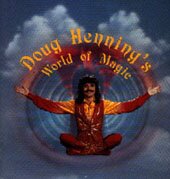
Bonus levitation.
5 Comments »
Posted by ben on January 25, 12:41 pm | Category: arts organizations, politics
Since Obama took office, I’ve seen a number of people call for the creation of a cabinet level Secretary of Arts (or Secretary of Culture), through op-eds, online petitions, and other channels. These proposals have left me cold for a few reasons. Most of the advocates of this measure frame it as a generic plea for the government to do more to support the arts. But why can’t congress just increase funding for the numerous federally controlled arts organizations that already exist? William Ferris also points out that the several existing arts-related government organizations (NEH, NEA, PBS, Library of Congress, Smithsonian, etc) sometimes have turf wars, and could benefit from some cabinet-level coordination and delineation of roles. Ok, but what is the nature of these conflicts, and could they be solved in another way?
I’ve not yet seen a really compelling argument for the Secretary of Arts position, which would, it must be admitted, seem rather frivolous to most Americans when the incoming administration has so many huge issues to deal with. A few days ago Tyler Green at Modern Art Notes proposed what seems like a much more practical move: appointing a White House arts adviser. Green takes as his model the White House science adviser, who deals with numerous agencies in coordinating a cohesive science policy. The White House arts adviser could play a similar role: advising the Department of Education on arts curriculum, the Pentagon on how to approach cultural monuments and institutions in occupied countries (remember the Iraq museum debacle?), the State Department on granting visas to visiting artists, etc. Apart from advising federal agencies, this arts advisor could help museums deal with the thorny issue of returning foreign artifacts to their home countries, and other non-federal matters that nonetheless have dimplomatic repercussions. Green discusses all these issues and more in laying out a pretty convincing case for this new appointment. Check it out.
1 Comment »
Posted by thomas-cummins on January 23, 2:01 pm | Category: design, typography
Ben’s link about Google’s philosophy towards a perpetually evolving brand is certainly a new corporate policy but logo evolution has always been around. San Antonio’s own AT&T morphed from an imposing Death Star logo to a more eco-friendly looking globe which the viewer can look down upon. Notice AT&T’s font also changed from the commanding CAPITALIZED letters to a more genial type.

at&t
My favorite is Starbucks’ logo though. The Seattle-based company started off with a traditional image of a mermaid but failed to realize she was nude and opening her legs for wandering sailors. I guess when you’re stuck on a boat with a bunch of men for months on end you begin to see women everywhere. As Starbucks grew into a blue chip Corporation they updated their obscene image by covering her breasts with her hair, cropping her legs off, and abstracting the entire image. Throughout the ages, the siren myth has always been a means for artists to portray how bodily impulses often lead us to disastrous results despite our better judgment. How fitting, then, that Starbucks similarly lures its customers in and convinces them to buy a $5 coffee despite their better judgment. How else does Starbucks make so much money just selling a drink? Because coffee is a legal drug.

Starbuck's Siren
1 Comment »
Posted by ben on January 22, 10:21 am | Category: links
I don’t think I’ve done this before, but I came across lots of interesting stuff this morning that I don’t have much to say about, so here’s one of those blog posts that’s just a list of links.
4 Comments »
Posted by aaron on January 20, 6:00 am | Category: celebrations, image & sound, music, politics
Performed by Los Dorados del Norte. Music & lyrics by… ?
3 Comments »
Posted by thomas-cummins on January 20, 4:10 am | Category: design, video/film

Stare at the black cross for 30 seconds.
The above image is an optical illusion sometimes referred to as the Lilac Chaser. It’s the result of several different known visual phenomena including:
Negative Afterimage – The everyday experience we have when we see something very bright and then continue to see its floating silhouette even after we look away from it. The neutral gray background seen here works to enhance this effect and this interactive site allows you to change the dot’s color to see opposing ghost colors.
Troxler’s Fading – First discovered in 1804 by Ignaz Troxler. Basically, we have a blind spot in the middle of our vision (called Scotoma) but we constantly make up for it by having two eyes, rapid eye movement, and also a brain that fills-in the missing information. Unvarying stimuli, however, is able to escape our focus. Similarly, we may feel our clothes when we first put them on but we soon forget about them even though they are still probably touching millions of neurons on our skin right now. A similar illusion is seen below and you can also test your blind spot at this website.

Filling-in
11 Comments »
Posted by ben on January 19, 3:44 pm | Category: music, r.i.p.
Posted by ben on January 19, 10:42 am | Category: poetry, politics, public art
Jim Fisher, discussing the challenges Elizabeth Alexander faces in writing an occasional poem for the inauguration, explains why this kind of poetry doesn’t usually work:
Why is poetry so different from other disciplines? Music and the plastic arts (painting, sculpture, architecture) are demonstrably receptive to commissions, with great works created on command, as it were. With sculptures and buildings, we only have to walk a few downtown blocks in most major cities to see lasting examples of both, pro and con.
The problem for poets is not the commission — Milton’s “Lycidas” and Marvell’s “Upon Appleton House” are both immortal poetry commissions — but the occasion, which fixes the poem with a public event. Once the function has passed, the poem loses the immediacy of its audience, and with it the power to summon meaning and emotion over time.
So let’s dispense with this idea that poets can produce lasting poems for public events. It’s unfair to the audience, discomposes the poet, and probably confirms the low opinion of poetry some listeners already hold.
When we read poetry to ourselves, the occasion of a great poem is an internal event, organizing the perceptions and determining the material. When that occasion is a point in time and place, the work is more likely to be stuck there when published: partial, responsible, contemporary, rarely timeless.
[hat tip]
8 Comments »
Posted by thomas-cummins on January 18, 3:02 pm | Category: interviews, politics, public art
Inauguration weekend is underway. Kurt Andersen investigates ‘Artists and Obama‘ at Studio360.org. You can find the following interviews there for your listening pleasure:
The Making of an Icon
Shepard Fairey, designer of the iconic red-white-and-blue Barack, and other Obama portraitists admit to riding the Obama wave but fear they might have over-hyped the president-elect to unrealistic expectations.
Dana Gioia
The departing chairman of the National Endowment for the Arts, Dana Gioia, was a Bush appointee but he’s down with a Democrat who reads poetry.
Voicemails for Barack: Part IV
Sculptor Richard Serra asks Obama for a Culture Minister as well as for a grassroots art movement.

- Shepard Fairey’s Obama Poster
2 Comments »
Posted by ben on January 16, 10:04 am | Category: intellectual property, politics, video/film
Nate Anderson at Ars Technica covers what is probably the best cause célèbre I’ve seen for oponents of restrictive copyright enforcement. The article recounts the case of Kevin Lee, a prolific film blogger who used YouTube extensively to publish “video essays” which interspersed his own critical insights with short film clips. Lee’s work demonstrates everything that’s good and noble about the Internet: an unpaid blogger pioneering new avenues of critical discourse, just to share his love of cinema with others. His blog, Shooting Down Pictures, reveals a passionate, intelligent observer documenting his travels through the greatest 1,000 films. Read more about the significance of Lee’s work at The House Next Door.
But all this came to a grinding halt when, after a third DMCA takedown notice was served against Lee, over five hours of his critical commentary was deleted by YouTube and his account closed. I’ve written about what I see as some helpful innovations on YouTube’s part in dealing with copyright, but this “three strikes” rule is absurd on its face. YouTube offers some fair objections to the idea that it should manually review all of these takedown notices, but deleting whole user accounts due to a small ammount of allegedly infringing content is bad for YouTube, bad for free speech, and will ultimately feed the backlash against copyright in general. It’s not even clear that the video that triggered the account deletion was violating copyright; Lee has a strong case that his critical videos fall under fair use protections.
The blame for this doesn’t fall entirely on YouTube, as many of the large rights holders are taking a “shoot first, ask questions later” stance with takedown notices, and of course the DMCA itself encourages this behavior. Any lasting solution will involve a combination of legal reform and consumers creating a shitstorm whenever something like this happens.
[Cross-posted at Scattered Work]
1 Comment »
Posted by ben on January 15, 12:56 pm | Category: r.i.p., tv
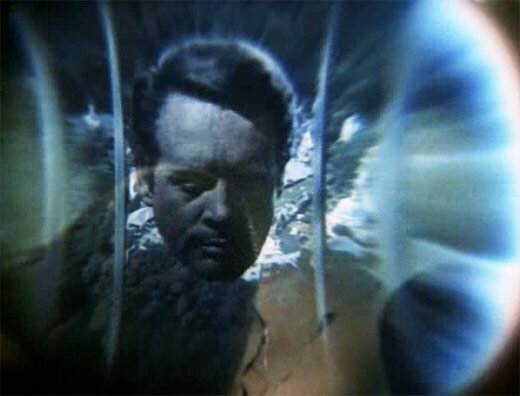
I’m very gratified because, when [The Prisoner] came out originally, in England, there were a lot of haters of it. A love/hate relationship, whichever way you look at it. Already there was a small cult. Now there’s a much bigger one over there. In fact, when the last episode came out in England, it had one of the largest viewing audiences, they tell me, ever over there, because everyone wanted to know who No. 1 was, because they thought it would be a “James Bond” type of No. 1. When they did finally see it, there was a near-riot and I was going to be lynched. And I had to go into hiding in the mountains for two weeks, until things calmed down. That’s really true!…
I wanted to have controversy, argument, fights, discussions, people in anger waving fist in my face saying, “How dare you? Why don’t you do more ‘Secret Agents’ that we can understand?” I was delighted with that reaction. I think it’s a very good one. That was the intention of the exercise….
— Patrick McGoohan, creator and star of The Prisoner, who died Tuesday
You can watch all 17 episodes of The Prisoner on the AMC website. The full Troyer interview (from which the quote above was taken) is transcribed here with .
3 Comments »
Posted by aaron on January 14, 12:47 pm | Category: arts organizations, essays, in yo face, music, mustaches, possibilities, public art, r.i.p., rock!, wordy

Manuel Diosdado Castillo, Jr. tragically succumbed to lung cancer on January 6th at the age of 40 – a matter of weeks after receiving the diagnosis – leaving behind a remarkable legacy of music, public artwork, of pride in and a powerful sense of responsibility for his beloved Westside San Antonio barrio. Manny was, for nearly twenty years, a singular presence in both the underground music scene in San Antonio (whose spiritual epicenter is marked by the centuries-old live oak tree at his favorite local dive/venue: the legendary, much-missed Tacoland) and in the non-profit community organization he built, originally as an offshoot project of Patti & Rod Radle’s Inner City Development, but which quickly blossomed into San Anto Cultural Arts.
My friendship with Manny goes back to a spontaneous garage rehearsal circa 1991. Marshall Gause and I were fruitlessly waiting at my folks’ house for some now forgotten drummer we wanted to try out, as our last band line-up hadn’t worked out. Marshall suggested trying to get in touch with this guy he had played a couple of times with the year before – they had enjoyed it, but it didn’t go anywhere as Manny soon left for New Orleans to follow Academic Pursuits. Marshall had a hunch he might be back in town now. After a few calls, the hunch was confirmed and we had a drummer on the way.
That first rehearsal (guitar, bass, & drums – singer Terry Brown had to work) immediately revealed an undeniable chemistry between Marshall’s hippy-punk musicologist guitar explorations, my intuitive but rudimentary bass playing (which, lucky for me, sounded better than it had much right to thanks to my chronic music obsession, a plethora of interesting audio exposure at a job selling used records, and especially Marshall’s unpretentious ability to cover for my lack of formal musical knowledge,) and Manny’s balls-out, hit-the-drums-hard-enough-to-break-at-least-one-head-per-session-but-always-dead-on-the-beat style, using complex rhythms even formally trained jazz drummers wouldn’t have the nerve to try. He was, and remains, one of the fastest, most precise drummers I have ever seen (even faster when he was nervous,) augmented by the physical strength to just bash the hell out of his drums – a steamroller cross between John Bonham, Neil Peart, Mitch Mitchell, George Hurley and Elvin Jones. All on a minimal and creaky drum set usually somehow held together with yarn.
That afternoon we quickly bonded musically over our mutual love for Rush, The Plugz, Esteban Jordan, Thin Lizzy and especially The Minutemen. Spontaneous jams we engaged in that day became the basis for numerous songs later fully developed and forming the initial base of our oeuvre (some still included in the set list at the time the band imploded.) In short order, we brought Terry back into the circle, sat around with some Lone Stars or whatever was cheap that day and soon agreed to call ourself El Santo, in homage to the legendary Mexican lucha enmascarada/film star who never lost a match.
Continue Reading »
3 Comments »
Posted by thomas-cummins on January 13, 11:04 pm | Category: possibilities, responses/reviews
I took the virtual Prado experience on Google Earth today and, overall, I have to say the hype is a little overblown. I flew into Madrid assuming Google would sweep me straight into the museum but was, instead, confronted by 14 masterpieces outside the Museum. I updated to the latest version of Google Earth and attempted to enter the Museum’s entrance like a video game but was still denied. What you do have access to is each of these paintings at an amazing 14,000 megapixels – which means you can see details never before possible to the general public. Sure, it’s definitely fun to float above craquelure but, in the end, this is only useful for a few specialists in the field of art history. What Google is really giving us is a preemptive glimpse of what is yet to come -that the Prado will eventually be virtualized for the benefit of everyone. This won’t take anything away from the museum experience itself but will, rather, enhance it – just as encyclopedias, tourist’s guide books, and postcards did once before. Don’t get me wrong, Google Earth is still awesome and gets better every month but who really won today were the P.R. firms for both Google and the Prado Museum itself. Just as the ‘Mona Lisa’ became even more famous in the mechanical age of reproduction so did the Museum in the virtual age of the internet. Google says they don’t plan on virtualizing other museums but don’t believe them – they won’t be happy until they document and record every frickin’ aura in the universe.
1 Comment »
Posted by ben on January 13, 4:23 pm | Category: art paparazzi, music, party photos, public art, r.i.p.
A few photos of Manny Castillo’s casket being painted by his friends and colleagues in the local art community:

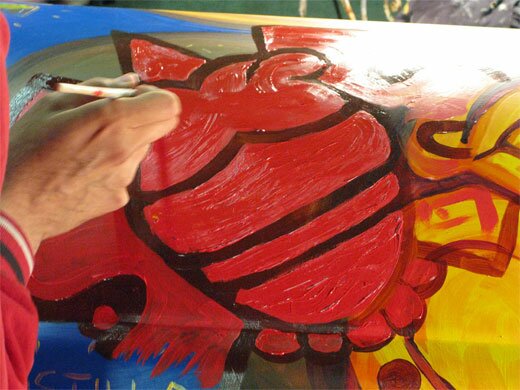


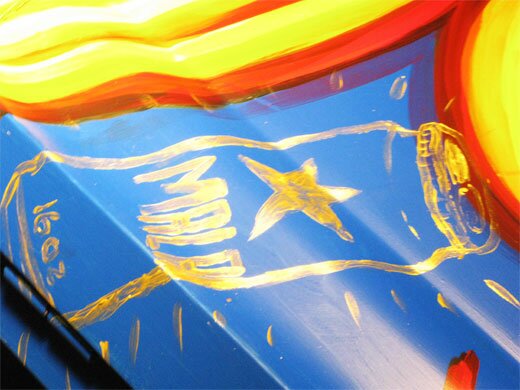
See also: San Antonio Express-News blog post with a number of murals facilitated by Castillo’s San Anto Cultural Arts; the Express-News obit; the San Antonio Current’s just before his death.
1 Comment »
Posted by ben on January 13, 11:44 am | Category: arts organizations, comics, design, video/film
Paul Richards’ article in the Washington Post advocating for a Disney-based museum show has inspired some interesting responses around the blogosphere. Greg Allen makes a plausible case that it’s nothing more than “a fanboi/critic [trying] to turn some offhand party chatter about the worst show ever into a mouse-eared museum manifesto.” Kriston Capps, in a more even-keeled post gets a bit closer to what I see as the real problem with the idea:
To admit Disney would be to open up a massive new genealogy in visual art that includes all the things that are visual but aren’t called art. So it wouldn’t be Disney and Murakami or Disney and younger fine artists but Disney and the makers of Final Fantasy or Disney and the Coca Cola designers. That might all be defensible, but it would get very confusing very quickly.
Just because something is important does not make it visual art and at the end of the day, just because something is visual art does not mean that it is represents the most important visual thing. Rather this notion of visual art you find at museums offers a streamlined conversation within visual culture, one that (one hopes) influences and is influenced by other conversations in the broader culture. But museums cannot hope to archive all those other conversations, too.
But I think it’s not just a question of what is deemed visual art or what is deemed important. The issue comes down to a more practical question of access. Museums allow us to see genuine, rare works of art from a field that was founded on prizing the unique object. When you start to show Mickey Mouse cartoons, interesting and important as they may be to visual culture, you’re showing people things they can already see in the comfort of their homes. It’s not that the material is inappropriate for the museum, but that museum treatment isn’t necessary. Without the museum, many of us would never get to see a Frank Stella except as a reproduction; but if all the museums in the world disappeared, we could still participate in the visual culture of cinema, more or less in the way it was intended to be viewed.
Maybe we’re past the point where we refuse to consider Disney or Alfred Hitchcock or Matt Groening to be “real artists,” but that doesn’t mean that the public would be well-served by seeing their work in museums.
1 Comment »
Posted by ben on January 12, 10:31 pm | Category: design, music

Death Messiah logo by Christophe Szpajdel
I was tipped off (by Design Observer) to an interview in Vice magazine with Christophe Szpajdel, who Vice calls “The Dark Lord of Logos” (but who Design Observer has dubbed “The Paul Rand of Metal”) — the designer responsible for the logos of over 7,000 metal bands.
2 Comments »
Posted by thomas-cummins on January 12, 9:02 pm | Category: art paparazzi, graffiti
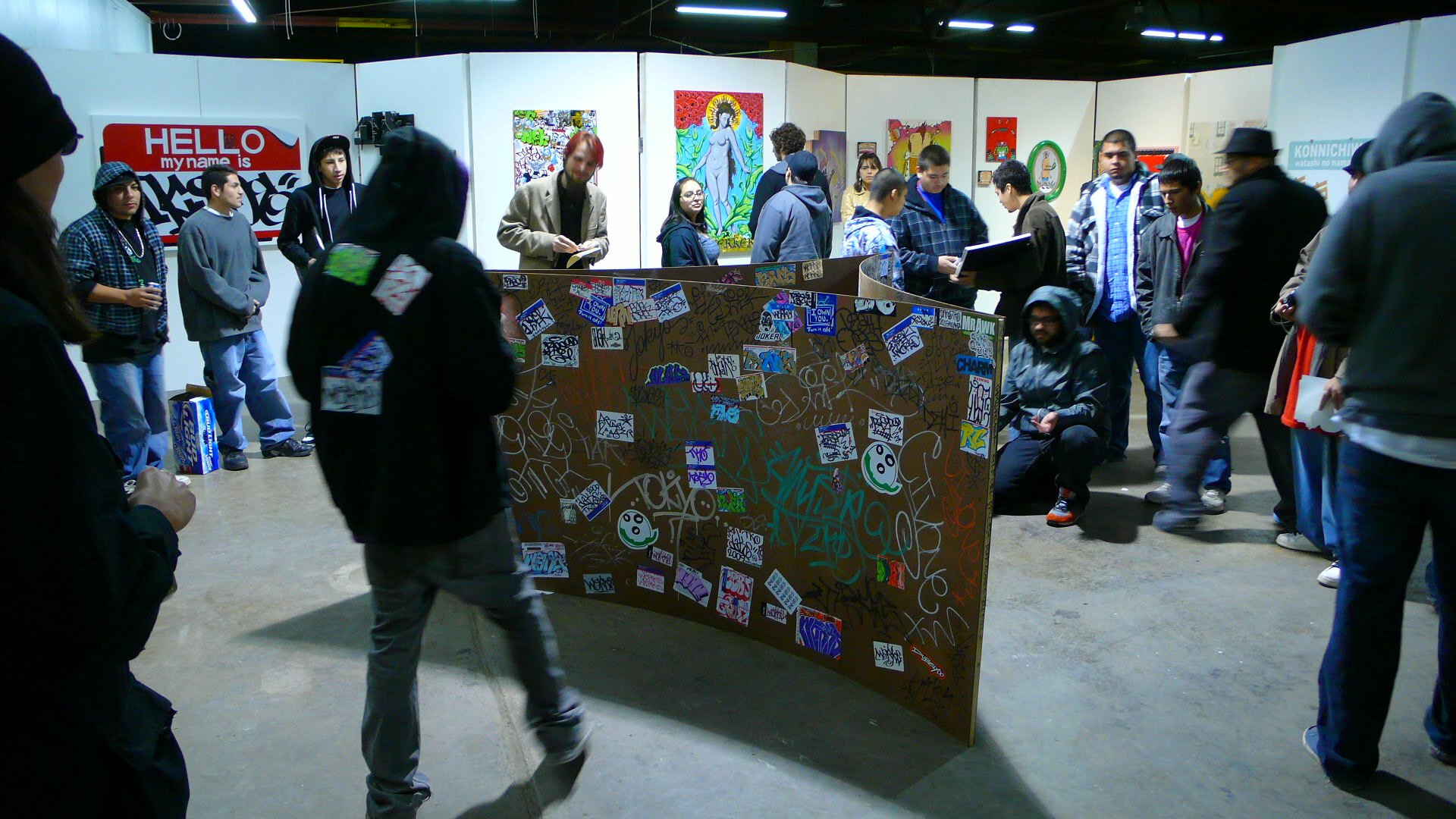
LoneStar Art Collaboration
See Rodriguez post below
3 Comments »
Posted by thomas-cummins on January 12, 2:02 pm | Category: celebrity sightings, video/film
Did anyone catch Jeff Koons‘ cameo in Gus Van Sant’s highly recommended film ‘Milk‘? His screen time was only about four minutes as San Francisco politician Art Agnos but it was interesting to see Koons actually kinda hold his own against such heavyweight actors as Josh Brolin, Emile Hirsch, James Franco, Diego Luna, and, of course, Sean Penn. It’s his first featured film (with his clothes on at least) and I’m wondering if this is a new direction for him or how exactly he got the role. I’ve googled around and nothing really comes up. Please comment below if you have any inside info. Oh, did anyone see ‘Maniac Nurses Find Ecstasy’? – it’s listed on his IMDb page.
2 Comments »
Posted by hillssnyder on January 12, 6:34 am | Category: uncategorized

huachuma

ayahuasca
2 Comments »
« Prev - Next »





















